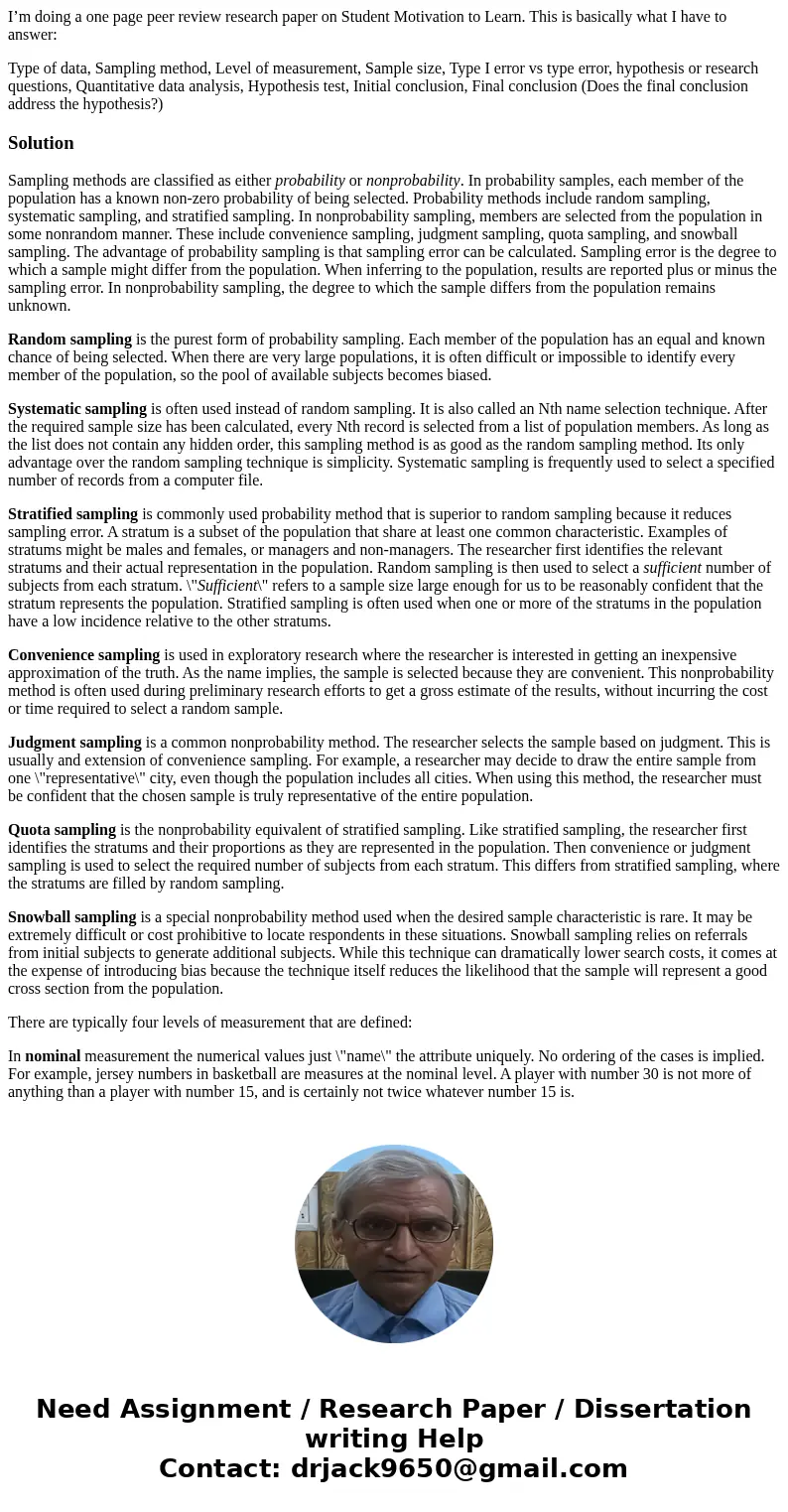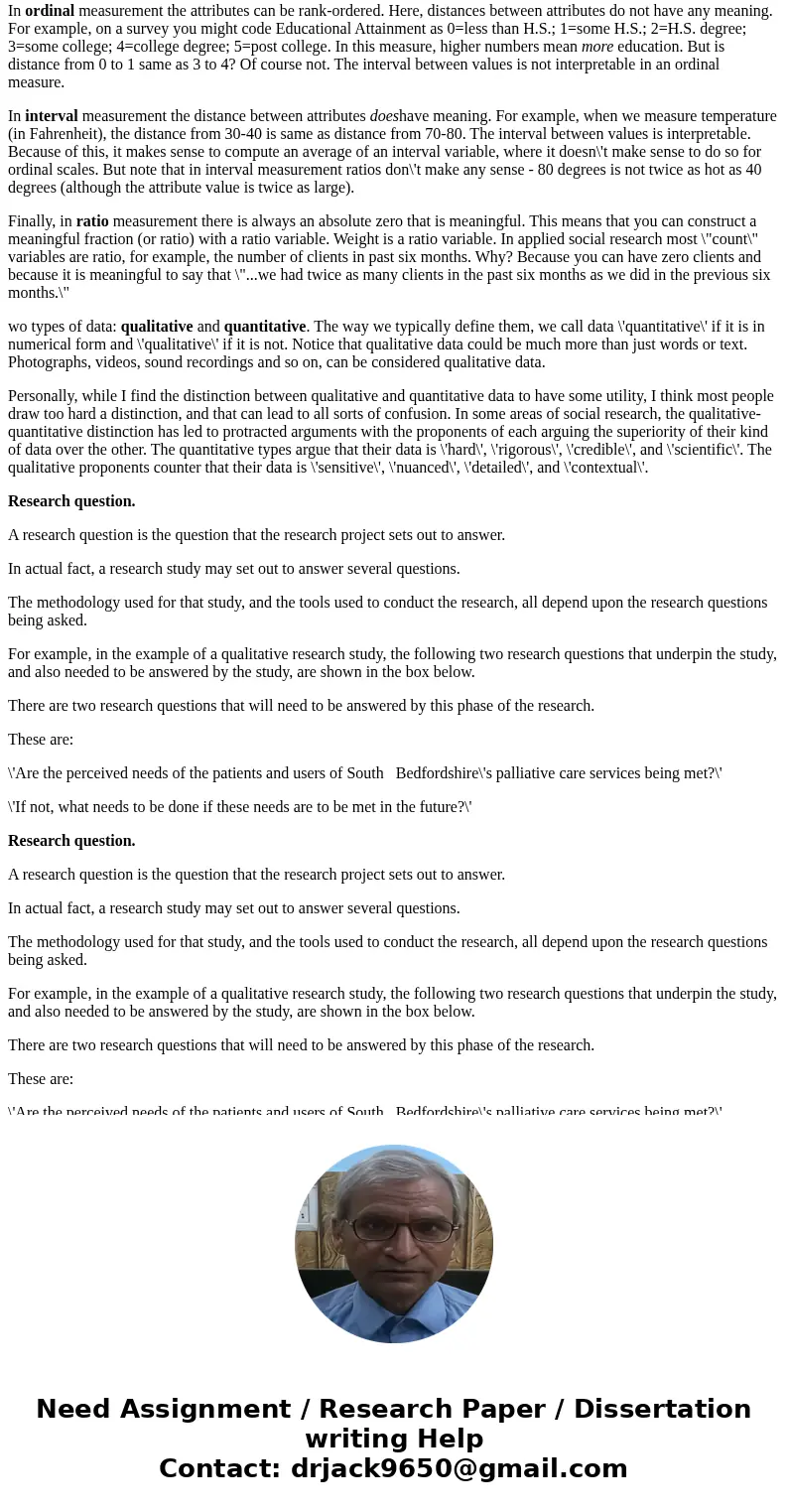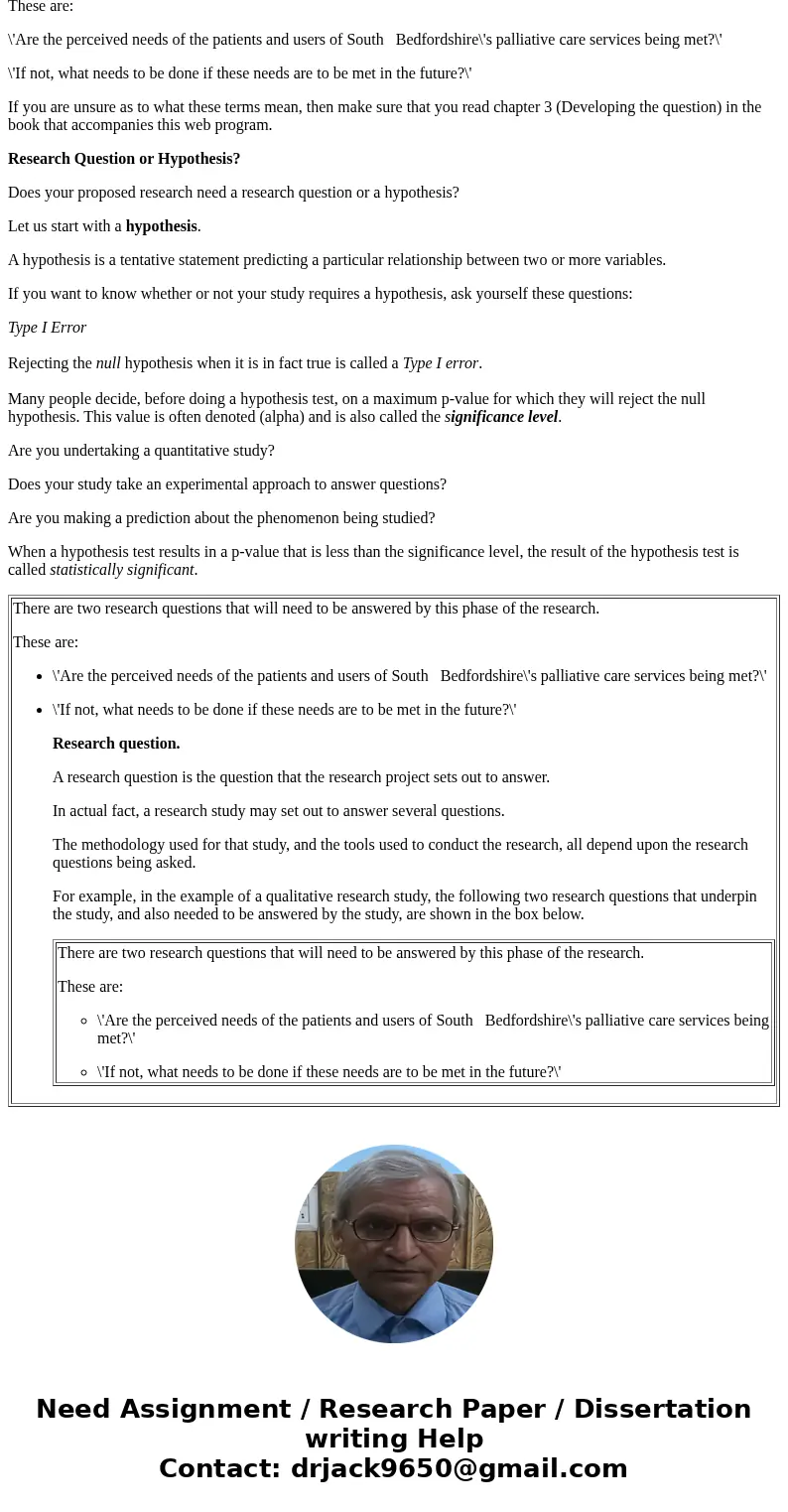Im doing a one page peer review research paper on Student Mo
I’m doing a one page peer review research paper on Student Motivation to Learn. This is basically what I have to answer:
Type of data, Sampling method, Level of measurement, Sample size, Type I error vs type error, hypothesis or research questions, Quantitative data analysis, Hypothesis test, Initial conclusion, Final conclusion (Does the final conclusion address the hypothesis?)
Solution
Sampling methods are classified as either probability or nonprobability. In probability samples, each member of the population has a known non-zero probability of being selected. Probability methods include random sampling, systematic sampling, and stratified sampling. In nonprobability sampling, members are selected from the population in some nonrandom manner. These include convenience sampling, judgment sampling, quota sampling, and snowball sampling. The advantage of probability sampling is that sampling error can be calculated. Sampling error is the degree to which a sample might differ from the population. When inferring to the population, results are reported plus or minus the sampling error. In nonprobability sampling, the degree to which the sample differs from the population remains unknown.
Random sampling is the purest form of probability sampling. Each member of the population has an equal and known chance of being selected. When there are very large populations, it is often difficult or impossible to identify every member of the population, so the pool of available subjects becomes biased.
Systematic sampling is often used instead of random sampling. It is also called an Nth name selection technique. After the required sample size has been calculated, every Nth record is selected from a list of population members. As long as the list does not contain any hidden order, this sampling method is as good as the random sampling method. Its only advantage over the random sampling technique is simplicity. Systematic sampling is frequently used to select a specified number of records from a computer file.
Stratified sampling is commonly used probability method that is superior to random sampling because it reduces sampling error. A stratum is a subset of the population that share at least one common characteristic. Examples of stratums might be males and females, or managers and non-managers. The researcher first identifies the relevant stratums and their actual representation in the population. Random sampling is then used to select a sufficient number of subjects from each stratum. \"Sufficient\" refers to a sample size large enough for us to be reasonably confident that the stratum represents the population. Stratified sampling is often used when one or more of the stratums in the population have a low incidence relative to the other stratums.
Convenience sampling is used in exploratory research where the researcher is interested in getting an inexpensive approximation of the truth. As the name implies, the sample is selected because they are convenient. This nonprobability method is often used during preliminary research efforts to get a gross estimate of the results, without incurring the cost or time required to select a random sample.
Judgment sampling is a common nonprobability method. The researcher selects the sample based on judgment. This is usually and extension of convenience sampling. For example, a researcher may decide to draw the entire sample from one \"representative\" city, even though the population includes all cities. When using this method, the researcher must be confident that the chosen sample is truly representative of the entire population.
Quota sampling is the nonprobability equivalent of stratified sampling. Like stratified sampling, the researcher first identifies the stratums and their proportions as they are represented in the population. Then convenience or judgment sampling is used to select the required number of subjects from each stratum. This differs from stratified sampling, where the stratums are filled by random sampling.
Snowball sampling is a special nonprobability method used when the desired sample characteristic is rare. It may be extremely difficult or cost prohibitive to locate respondents in these situations. Snowball sampling relies on referrals from initial subjects to generate additional subjects. While this technique can dramatically lower search costs, it comes at the expense of introducing bias because the technique itself reduces the likelihood that the sample will represent a good cross section from the population.
There are typically four levels of measurement that are defined:
In nominal measurement the numerical values just \"name\" the attribute uniquely. No ordering of the cases is implied. For example, jersey numbers in basketball are measures at the nominal level. A player with number 30 is not more of anything than a player with number 15, and is certainly not twice whatever number 15 is.
In ordinal measurement the attributes can be rank-ordered. Here, distances between attributes do not have any meaning. For example, on a survey you might code Educational Attainment as 0=less than H.S.; 1=some H.S.; 2=H.S. degree; 3=some college; 4=college degree; 5=post college. In this measure, higher numbers mean more education. But is distance from 0 to 1 same as 3 to 4? Of course not. The interval between values is not interpretable in an ordinal measure.
In interval measurement the distance between attributes doeshave meaning. For example, when we measure temperature (in Fahrenheit), the distance from 30-40 is same as distance from 70-80. The interval between values is interpretable. Because of this, it makes sense to compute an average of an interval variable, where it doesn\'t make sense to do so for ordinal scales. But note that in interval measurement ratios don\'t make any sense - 80 degrees is not twice as hot as 40 degrees (although the attribute value is twice as large).
Finally, in ratio measurement there is always an absolute zero that is meaningful. This means that you can construct a meaningful fraction (or ratio) with a ratio variable. Weight is a ratio variable. In applied social research most \"count\" variables are ratio, for example, the number of clients in past six months. Why? Because you can have zero clients and because it is meaningful to say that \"...we had twice as many clients in the past six months as we did in the previous six months.\"
wo types of data: qualitative and quantitative. The way we typically define them, we call data \'quantitative\' if it is in numerical form and \'qualitative\' if it is not. Notice that qualitative data could be much more than just words or text. Photographs, videos, sound recordings and so on, can be considered qualitative data.
Personally, while I find the distinction between qualitative and quantitative data to have some utility, I think most people draw too hard a distinction, and that can lead to all sorts of confusion. In some areas of social research, the qualitative-quantitative distinction has led to protracted arguments with the proponents of each arguing the superiority of their kind of data over the other. The quantitative types argue that their data is \'hard\', \'rigorous\', \'credible\', and \'scientific\'. The qualitative proponents counter that their data is \'sensitive\', \'nuanced\', \'detailed\', and \'contextual\'.
Research question.
A research question is the question that the research project sets out to answer.
In actual fact, a research study may set out to answer several questions.
The methodology used for that study, and the tools used to conduct the research, all depend upon the research questions being asked.
For example, in the example of a qualitative research study, the following two research questions that underpin the study, and also needed to be answered by the study, are shown in the box below.
There are two research questions that will need to be answered by this phase of the research.
These are:
\'Are the perceived needs of the patients and users of South Bedfordshire\'s palliative care services being met?\'
\'If not, what needs to be done if these needs are to be met in the future?\'
Research question.
A research question is the question that the research project sets out to answer.
In actual fact, a research study may set out to answer several questions.
The methodology used for that study, and the tools used to conduct the research, all depend upon the research questions being asked.
For example, in the example of a qualitative research study, the following two research questions that underpin the study, and also needed to be answered by the study, are shown in the box below.
There are two research questions that will need to be answered by this phase of the research.
These are:
\'Are the perceived needs of the patients and users of South Bedfordshire\'s palliative care services being met?\'
\'If not, what needs to be done if these needs are to be met in the future?\'
If you are unsure as to what these terms mean, then make sure that you read chapter 3 (Developing the question) in the book that accompanies this web program.
Research Question or Hypothesis?
Does your proposed research need a research question or a hypothesis?
Let us start with a hypothesis.
A hypothesis is a tentative statement predicting a particular relationship between two or more variables.
If you want to know whether or not your study requires a hypothesis, ask yourself these questions:
Type I Error
Rejecting the null hypothesis when it is in fact true is called a Type I error.
Many people decide, before doing a hypothesis test, on a maximum p-value for which they will reject the null hypothesis. This value is often denoted (alpha) and is also called the significance level.
Are you undertaking a quantitative study?
Does your study take an experimental approach to answer questions?
Are you making a prediction about the phenomenon being studied?
When a hypothesis test results in a p-value that is less than the significance level, the result of the hypothesis test is called statistically significant.
| There are two research questions that will need to be answered by this phase of the research. These are:
|



 Homework Sourse
Homework Sourse